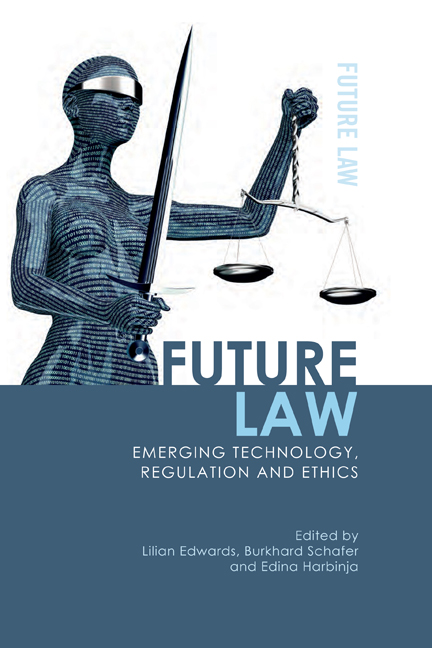Book contents
- Frontmatter
- Contents
- List of Contributors
- List of Figures and Tables
- Table of Cases
- Table of Legislation
- 1 The Future’s Already Here: It’s Just Unevenly Edited
- Part I From Privacy and Princesses, to Security and Star Wars
- 2 Privacy and Identity through the Eyes of Disney Princesses
- 3 White Noise from the White Goods? Privacy by Design for Ambient Domestic Computing
- 4 Citizen-consumers in a Personalised Galaxy: Emotion-influenced Decision Making, a True Path to the Dark Side?
- 5 Big Data Ethics: Darth Vader and the Green Cross Man
- 6 Security Vulnerabilities, Backdoors, Exploits and the Marketplace for Each: The Return of Boba Fett – Bug Bounty Hunter in the New Republic
- Part II A Matter of (Future) Life and Death
- 7 Will My Genes Really Help Me Fit Into Those Jeans? Personal Genomics and Wrap Contracts
- 8 On Living and Undead Wills: ZombAIs, Technology and the Future of Inheritance Law
- 9 ‘Be Right Back’: What Rights Do We Have over Post-mortem Avatars of Ourselves?
- Part III Regulating Autonomous Technologies: Software Are Doing it for Themselves
- 10 Autonomous Intelligent Agents and the Roman Law of Slavery
- 11 Autonomous Vehicles: An Analysis of the Regulatory and Legal Landscape
- Part IV Textual Poaching: Copyright in a Remixed World
- 12 Living in a Remixed World: Comparative Analysis of Transformative Uses in Copyright Law
- 13 Repost This: Instagram and the Art of Re-photography
- Index
9 - ‘Be Right Back’: What Rights Do We Have over Post-mortem Avatars of Ourselves?
Published online by Cambridge University Press: 17 September 2020
- Frontmatter
- Contents
- List of Contributors
- List of Figures and Tables
- Table of Cases
- Table of Legislation
- 1 The Future’s Already Here: It’s Just Unevenly Edited
- Part I From Privacy and Princesses, to Security and Star Wars
- 2 Privacy and Identity through the Eyes of Disney Princesses
- 3 White Noise from the White Goods? Privacy by Design for Ambient Domestic Computing
- 4 Citizen-consumers in a Personalised Galaxy: Emotion-influenced Decision Making, a True Path to the Dark Side?
- 5 Big Data Ethics: Darth Vader and the Green Cross Man
- 6 Security Vulnerabilities, Backdoors, Exploits and the Marketplace for Each: The Return of Boba Fett – Bug Bounty Hunter in the New Republic
- Part II A Matter of (Future) Life and Death
- 7 Will My Genes Really Help Me Fit Into Those Jeans? Personal Genomics and Wrap Contracts
- 8 On Living and Undead Wills: ZombAIs, Technology and the Future of Inheritance Law
- 9 ‘Be Right Back’: What Rights Do We Have over Post-mortem Avatars of Ourselves?
- Part III Regulating Autonomous Technologies: Software Are Doing it for Themselves
- 10 Autonomous Intelligent Agents and the Roman Law of Slavery
- 11 Autonomous Vehicles: An Analysis of the Regulatory and Legal Landscape
- Part IV Textual Poaching: Copyright in a Remixed World
- 12 Living in a Remixed World: Comparative Analysis of Transformative Uses in Copyright Law
- 13 Repost This: Instagram and the Art of Re-photography
- Index
Summary
Introduction: Staring into the Black Mirror?
In the well-received Black Mirror episode, ‘Be Right Back’, a grieving young widow, Martha, decides she can no longer live without some kind of contact with her partner, Ash, who has died prematurely in a freak car accident – especially when she finds out she is posthumously pregnant by him. A friend points her in the direction of a service that synthesises convincing emails from Ash, using artificial intelligence (AI) techniques, working on a corpus of material drawn from social media posts, emails and direct messages to which she has access, and she finds this relieves her intense misery. This leads her on to a second stage of recreating her dead partner: adding sound and video. This time it is explicitly noted that the app can use material drawn from private videos and photos as well as publicly posted information (and Martha is required to consent to this); the app creates a simulated ‘Ash’ that can chat on the phone to Martha in a naturalistic way.
There is however no attempt to dupe Martha; one of the first things the new Ash says (jokingly) is ‘How can I have a voice? I don't even have a mouth!’ New Ash mimics the humour, voice patterns and mannerisms of Old Ash but at the same time displays access to knowledge (including video) drawn from sources like Google in a rather un-humanlike way. At one point, Martha drops the phone New Ash is resident on, and is distraught she has lost him, but after a recompilation, the simulacrum is restored. Again, New Ash is quite sanguine about letting Martha know about his artificial nature:
‘I’m not in that thing, I’m in the cloud.’ This crisis leads New Ash himself (a tremendous piece of upselling) to recommend to Martha that she goes one crucial step further and makes or rather ‘grows’ him a body under his directions. At this point, the production seems to imply we have shifted from the merely creepy to the possibly illegal, but this is never explicitly discussed.
The body is in some senses a triumph and in others a failure. It looks and acts like Real Ash, able to restore intimacy to Martha, and yet it isn’t, quite.
- Type
- Chapter
- Information
- Future LawEmerging Technology, Regulation and Ethics, pp. 262 - 292Publisher: Edinburgh University PressPrint publication year: 2020

